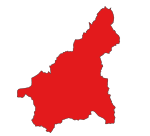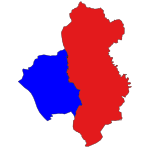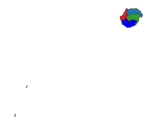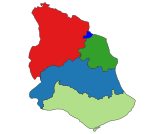Administrative region of Myanmar Region in Lower Myanmar, Myanmar
| Yangon Region ရန်ကုန်တိုင်းဒေသကြီးRangoon Region | |
|---|---|
| Region | |
| Yangon Region | |
 Flag Flag Seal Seal | |
| Nickname: YGN | |
 Location of Yangon Region Location of Yangon Region | |
| Coordinates: 17°0′N 96°10′E / 17.000°N 96.167°E / 17.000; 96.167 | |
| Country | |
| Region | Lower Myanmar |
| Capital | Yangon |
| Government | |
| • Chief Minister | Hla Soe |
| • Cabinet | Yangon Region Government |
| • Legislature | Yangon Region Hluttaw |
| • Judiciary | Yangon Region High Court |
| Area | |
| • Total | 10,276.7 km (3,967.9 sq mi) |
| • Rank | 14th |
| Highest elevation | 484 m (1,588 ft) |
| Population | |
| • Total | 7,360,703 |
| • Rank | 1st |
| • Density | 720/km (1,900/sq mi) |
| Demonym | Yangonite |
| Demographics | |
| • Ethnicities | Bamar, Kayin, Rakhine, Chinese, Indians, Mon |
| • Religions | Buddhism, Christianity, Hinduism, Islam |
| Time zone | UTC+6:30 (MST) |
| ‘Area code(s)' | 01 |
| ISO 3166 code | MM |
| Literacy rate (2014) | 96.6% |
| HDI (2017) | 0.641 medium · 1st |
| Website | yangon |
Yangon Region (Burmese: ရန်ကုန်တိုင်းဒေသကြီး; MLCTS: rankun tuing desa. kri:, pronounced [jàɰ̃ɡòʊɰ̃ táɪɰ̃ dèθa̰ dʑí]; formerly Rangoon Division and Yangon Division) is an administrative region of Myanmar. Located in central Myanmar, the region is bordered by Bago Region to the north and east, the Gulf of Martaban to the south, and Ayeyarwady Region to the west. Yangon Region is dominated by its capital city of Yangon, the former national capital and the largest city in the country. Other important cities are Thanlyin and Twante. The division is the most developed region of the country and the main international gateway. The division measures 10,170 km (3,930 sq mi).
History
The region was historically populated by the Mon. Politically, the area was controlled by Mon kingdoms prior to 1057, and after 1057, with few exceptions, by Burman kingdoms from the north. The control of the region reverted to Pegu-based Mon kingdoms in the 13th to 16th centuries (1287–1539) and briefly in the 18th century (1740–57). The Portuguese were in control of Thanlyin (Syriam) and the surrounding area from 1599 to 1613.
For centuries, Thanlyin was the most important port city in Lower Myanmar until the mid-18th century when King Alaungpaya chose to enlarge a small village across the river near the great Shwedagon Pagoda named Dagon.
The British first captured Yangon in the First Anglo-Burmese War (1824–26) but returned it to Burmese administration after the war. The British seized Yangon and all of Lower Burma in the Second Anglo-Burmese War of 1852, and subsequently transformed Yangon into the commercial and political hub of British Burma. Yangon was the capital of British Burma and Hanthawaddy Province, which covered today's Yangon and Bago divisions. The British brought in many Indians to serve as workers and civil servants. By the 1930s, the Indians made up half of Yangon city, and only one-third was Burmese.
Between World War I and World War II, Yangon was the center of the Burmese nationalist movement. Many future Burmese political figures such as Aung San, U Nu, U Thant and Ne Win were all one-time Rangoon University students. Yangon Region was under Japanese occupation between April 1942 and May 1945.
After Myanmar gained independence from the United Kingdom in January 1948, the Hanthawaddy Province was renamed Pegu (Bago) Division, with Yangon as its capital. In 1964, Rangoon Division was split from Pegu Division. The capital of Pegu Division was changed from Rangoon to Pegu. In June 1974, Hanthawaddy (Hongsavatoi) and Hmawbi townships were transferred from Pegu Division to Rangoon Division.
Post-war Yangon grew tremendously. Successive Burmese governments built satellite towns near Yangon. Today, Yangon Region is essentially the Greater Yangon metropolitan area surrounded by a hollow rural hinterland.
Administrative divisions
There were only four districts in Yangon Region. On 30 April 2022, these districts were expanded to 14 districts by the provisional government. Of the 45, the city of Yangon now encompasses 33 townships.

Government
Executive
Legislative
Judiciary
Demographics
| Year | Pop. | ±% |
|---|---|---|
| 1973 | 3,190,359 | — |
| 1983 | 3,973,626 | +24.6% |
| 2014 | 7,360,703 | +85.2% |
| Source: 2014 Myanmar Census | ||
The ethnic Burmese makes up the majority of the population. The division is also home to a large number of South Asians (mainly Indians) and Burmese Chinese. According to 2014 census report, the population of Yangon region is 7.36 million. Burmese is the primary language used by Burmese of all ethnic backgrounds. English is the main second language among the urban elite of Yangon.
Religion
Religion in Yangon Region (2014)
Buddhism (91%) Islam (4.7%) Christianity (3.2%) Hinduism (1.0%) Other religion (0.1%)According to the 2014 Myanmar Census, Buddhists make up 91% of Yangon Region's population, forming the largest religious community there. Minority religious communities include Christians (3.2%), Muslims (4.7%), and Hindus (1%) who collectively comprise the remainder of Yangon Region's population. 0.1% of the population listed no religion, other religions, or were otherwise not enumerated.
According to the State Sangha Maha Nayaka Committee’s 2016 statistics, 88,442 Buddhist monks were registered in Yangon Region, comprising 16.5% of Myanmar's total Sangha membership, which includes both novice samanera and fully-ordained bhikkhu. The majority of monks belong to the Thudhamma Nikaya (81.2%), followed by Shwegyin Nikaya (13.6%), with the remainder of monks belonging to other small monastic orders. 16,960 thilashin were registered in Yangon Region, comprising 28.1% of Myanmar's total thilashin community, the largest in Myanmar.
Economy
See also: Yangon § EconomyYangon Region is the most developed region in the country. According to the government's official statistics for FY 2010–2011, the size of the economy of Yangon Region was 8.93 trillion kyat, or 23% of the national GDP. Greater Yangon is Lower Myanmar's main trading hub for all kinds of merchandise – from basic food stuffs to used cars. Bayinnaung Market is the largest wholesale center in the country for rice, beans and pulses, and other agricultural commodities. Much of the country's legal imports and exports go through Thanlyin's Thilawa port, the largest and busiest port in Myanmar. At least 14 light industrial zones ring Yangon, employing thousands of workers. Outside Greater Yangon, rice farming remains predominant. Other important crops include jute, pulses, rubber, sugarcane, and groundnut.
Transport
See also: Yangon § TransportYangon Region has the best transportation infrastructure in the country. All transport to and from the rest of the country (and the world) goes through Yangon. Five "highways" link Yangon to the rest of the country. (To be sure, the definition of highway is loosely used. Most highways are no more than two lane roads.) Yangon International Airport is the main international gateway of the country. Yangon Central Railway Station is a major hub of the 5,068-kilometre (3,149 mi) Myanmar Railways system. Twante Canal, which links Yangon to Ayeyarwady Region, is also widely used for both transport and commerce.
As motor transportation is highly expensive for most people, buses are the main mode of transportation within the division or regions nearby. In January 2008, Yangon Region had nearly 182,000 motor vehicles, 17.7% of the country's total.
Education
See also: List of universities in Yangon DivisionAlthough the city of Yangon has the best education facilities in the country, the educational facilities and opportunities available in the rest of Yangon Region are extremely poor. Many students in rural and poor districts do not finish middle school. According to official statistics, only about 23% of primary school students make it to high school. Most students are enrolled in the public school system. Private schools, which cost at least $8,000 a year in tuition per student, are strictly the preserve of the elite.
| AY 2002-2003 | Primary | Middle | High |
|---|---|---|---|
| Schools | 2,245 | 240 | 158 |
| Teachers | 15,600 | 10,100 | 3600 |
| Students | 540,000 | 302,000 | 123,000 |
Nearly all of the division's universities are in Greater Yangon. Dagon University in North Dagon and the University of East Yangon in Thanlyin are among the largest undergraduate universities in the country. Yangon's University of Medicine 1, Yangon, University of Medicine 2, Yangon, Yangon Technological University, University of Computer Studies, Yangon and Thanlyin's Myanmar Maritime University are among the most selective universities in Myanmar.
The University of West Yangon in Htantabin and the Officers Training School in Hmawbi are two major institutions of higher education outside Greater Yangon.
Health care
See also: List of hospitals in Yangon and Yangon General HospitalThe general state of health care in Myanmar is poor. The military government spends anywhere from 0.5% to 3% of the country's GDP on health care, consistently ranking among the lowest in the world. Although health care is nominally free, in reality, patients have to pay for medicine and treatment, even in public clinics and hospitals. Public hospitals lack many of the basic facilities and equipment. Still, Yangon Region has the best medical facilities and personnel available in the country. The following is a summary of the public health system in the division, in the fiscal year 2002-2003.
| 2002–2003 | # Hospitals | # Beds |
|---|---|---|
| Specialist hospitals | 9 | 3,800 |
| General hospitals with specialist services | 8 | 3,220 |
| General hospitals | 26 | 1,055 |
| Health clinics | 24 | 384 |
| Total | 67 | 8,459 |
References
- ^ Census Report. The 2014 Myanmar Population and Housing Census. Vol. 2. Naypyitaw: Ministry of Immigration and Population. May 2015. p. 17.
- The Union Report: Census Report Volume 2. The 2014 Myanmar Population and Housing Census. Nay Pyi Taw: Ministry of Immigration and Population. 2015. p. 12.
- "Sub-national HDI - Area Database - Global Data Lab". hdi.globaldatalab.org. Retrieved 2018-09-13.
- ^ "Myanmar Divisions". Statoids. Retrieved 10 April 2009.
- ^ "Yangon Division". Bookrags.com. Retrieved 2008-12-25.
- Maung Htin Aung (1967). A History of Burma. New York and London: Columbia University Press.
- "History of Yangon". Myanmar's Net. Retrieved 25 December 2008.
- Thant Myint-U (2006). The River of Lost Footsteps, Histories of Burma. New York: Farrar, Straus and Giroux. ISBN 978-0-374-16342-6.
- "Myanmar States/Divisions and Townships" (PDF). Myanmar Information Management Unit. December 2007.
- "EXPANSION OF NEW DISTRICTS: NEW DISTRICTS EXPANDED IN NAY PYI TAW, REGIONS AND STATES".
- "District Maps in Yangon City Development Committee Boundary".
- "နေပြည်တော်၊ တိုင်းဒေသကြီးနှင့် ပြည်နယ်များတွင် ခရိုင် ၄၆ ခရိုင် အသစ်တိုးချဲ့ဖွဲ့စည်းသည့်အတွက် စုစုပေါင်းခရိုင် ၁၂၁ ခရိုင်ရှိလာ".
- The 2014 Myanmar Population and Housing Census. 2015.
- Department of Population Ministry of Labour, Immigration and Population MYANMAR (July 2016). The 2014 Myanmar Population and Housing Census Census Report Volume 2-C. Department of Population Ministry of Labour, Immigration and Population MYANMAR. pp. 12–15.
- ^ The 2014 Myanmar Population and Housing Census Census Report Volume 2-C (PDF). Department of Population Ministry of Labour, Immigration and Population. July 2016. pp. 12–15.
- ^ "The Account of Wazo Monks and Nuns in 1377 (2016 year)". State Sangha Maha Nayaka Committee. 2016. Retrieved 2021-01-19.
- Kyaw Hsu Mon and Yadana Htun (2011-11-07). "Yangon Region govt facing K22b budget black hole". The Myanmar Times.
- "Industrial Zones". Ministry of Industry 2, Myanmar. Retrieved 2008-12-25.
- Kyi Kyi Hla (2001-02-01). "Ngamoeyeik Bridge".
- "Third Regional EST Forum: Presentation of Myanmar" (PDF). Singapore: Ministry of Transport, Myanmar. 17–19 March 2008.
- "Education statistics by level and by State and Division". Myanmar Central Statistical Organization. Retrieved 2009-04-09.
- Sandra Davie (2008-10-13). "I see no future for my two sons in Myanmar". The Straits Times.
- Minh Zaw (2008-03-28). "HR key to development". The Myanmar Times.
- "PPI: Almost Half of All World Health Spending is in the United States". 2007-01-17.
- Yasmin Anwar (2007-06-28). "Burma junta faulted for rampant diseases". UC Berkeley News.
- "Hospitals and Dispensaries by State and Division". Myanmar Central Statistical Organization. Retrieved 2009-04-11.
External links
- Taipei American Chamber of Commerce; Topics Magazine, Analysis, November 2012. Myanmar: Southeast Asia's Last Frontier for Investment, BY DAVID DUBYNE
| Places adjacent to Yangon Region | ||||||||||||||||
|---|---|---|---|---|---|---|---|---|---|---|---|---|---|---|---|---|
| ||||||||||||||||
| Yangon Region | ||
|---|---|---|
| Capital: Yangon | ||
| East Yangon District |  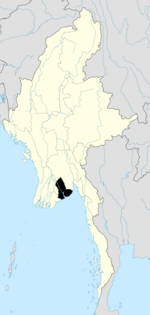 | |
| North Yangon District | ||
| South Yangon District | ||
| West Yangon District (Downtown) | ||
| Main cities and towns | ||
| - part of South Yangon City; - part of North Yangon City | ||
| Administrative divisions of Myanmar | ||
|---|---|---|
| States | ||
| Regions | ||
| Self-Administered Zones | ||
| Self-Administered Divisions | ||
| Union Territories | ||
"MM".
Categories: